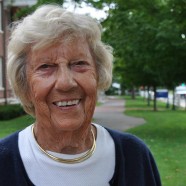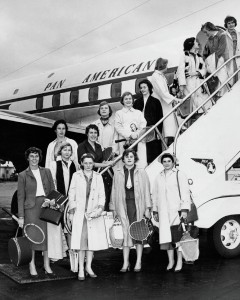
Carol “Haussie” Haussermann ’43 is an athlete of national stature. She played field hockey, squash and lacrosse, and coached girls for decades.
“I simply loved to play field hockey,” Carol says, beginning her story at the beginning. That was the early 1940s at Milton. Carol chose to keep playing.
Well past college, through escalating levels of teams, field hockey represented discovery as well as pleasure. Over time, playing the game allowed her to take risks, define a unique career, and nurture the players who followed. Eventually, lacrosse joined field hockey in her life, and in 1994 she was elected to the National Lacrosse Hall of Fame.
“We were all alike, those of us who lived and went to school together,” Carol says. “Field hockey allowed me to meet completely different people and realize a whole other world outside what I had known.”
Carol tried out for and earned a place on the Boston Field Hockey Association team, then the New England team, and ultimately on the team that represented the United States. She participated in three international tours, playing throughout Scandanavia, western Europe and Africa during the late 1940s and early 1950s. Players stayed with host families during the tours. Deep friendships developed among teammates, like Carol’s with Maggie Boyd—“one of England’s great players and a pioneer,” Carol explains. The experience of traveling and playing internationally, and being followed by enthusiastic fans, was transformative. “We didn’t take ourselves so very seriously,” Carol says, “but we knew that if we practiced hard enough, we could compete internationally, and we wouldn’t embarrass our country.”
This playing trajectory wrapped Carol into a long, lively tradition of exchange between England and the United States. Skilled female athletes, usually also figures at premier English schools, routinely ran clinics and camps in the northeast United States, developing young players and coaches. The women who managed the well-known camps trained coaches for programs at many of the schools and colleges up and down the East Coast.
In fact, Carol’s work as coach and counselor at Camp Merestead—which describes itself as “the oldest sports camp for girls in the United States”—gave rise to Athletic Director May Fogg’s invitation for Carol to join the Winsor School faculty in 1948. “I give credit to Winsor faculty,” Carol says, “for sharing with me, the baby of the group, their devotion to students’ lives. Learning from them, hands-on and by osmosis, was a thrilling experience.” Carol taught physical education, geography and spelling before joining the math department. She is still close to her favorite seventh-grade class, now in their 70s. Winsor was also particularly accommodating of Carol’s international tournament invitations.
Carol took a risk and catapulted into a career as a camp owner by buying Camp Merestead’s rights and equipment when it became available. With Maggie Boyd as her partner, and with the help of another English player, the camp grew. To accommodate the players, Carol moved it to new locations, first in Poland Spring, Maine, and then in Vermont. She located another in Maryland and increased the number of New England camps. Having learned about running a complex organization by doing it, Carol owned camps that trained 1,500 girls each summer with staff totaling 500. The camps offered one-, two- or three-week programs, built on the model of Carol’s own camping days: topnotch, experienced coaches from the United States and from Europe, and a well-rounded program with educational speakers and music. Carol would serve as “head honcho” at one camp and her associate directors would run the others. In that era, developers of athletes cooperated with one another. Carol and director-owners of other elite sports training camps tried to make their schedules contiguous, which made sharing, cultivating and promoting talented coaches possible.
Since Carol knew the top talent in coaching, she was not surprised to receive a call in 1968 from the College of William and Mary in Virginia. The college’s athletic director, seeking candidates for a field hockey coaching position, was surprised to find Carol herself interested. Once Carol was established at William and Mary, the athletic director asked her to start the school’s lacrosse program. Carol’s business partner and teammate Maggie Boyd had written the definitive book about coaching lacrosse, and all Carol’s Boston field hockey teammates also played the sport. Carol’s field hockey team formed the college’s first lacrosse team. “I could teach it better than play it,” Carol says. “It’s a beautiful sport, a game of skill and spaces.”
A coach helps an athlete build a complex set of skills. The best athletes are not only physically adept, but also resourceful and optimistic. They make choices, rebound quickly, and create new chances for success. They understand their dependence on and responsibility toward others. Carol modeled these concepts, but how did she teach them?
“Honestly,” Carol says, “it came naturally. I don’t remember a self-conscious effort. Thirty and 40 years ago, games were free flowing: nonphysical, in the sense that you did not bump or whack another player. I was taught by wonderful women and followed their example. We helped girls mature, get to know one another and themselves. We helped them understand how they were performing. We were not hypercritical. We taught by praise and by encouragement. I don’t remember ever losing my temper, nor do I remember anyone losing her temper at me.”
Following six years as president of the U.S.A. Squash Association and 15 years as fi rst vice president of the U.S.A. Women’s Field Hockey Association, Carol continued to demonstrate her organizational zeal through the other arm of her career. As her citation in the Lacrosse Hall of Fame notes, “[Carol’s] contributions to the administration of the game have been unsurpassed. She was a very active president of the Virginia Women’s Lacrosse Association, which helped it grow. She was president of the United States Women’s Lacrosse Association from 1968 to 1974. In 1986, she built up the USWLA Home Office, served as the organization’s first executive director until 1990, and was instrumental in initiating USWLA fund-raising programs.”
Title IX, the amendment to the Civil Rights Act that was used to guarantee equal access to sports for girls, was passed in 1972, as Carol closed the coaching chapter of her life. Guarantees of equal playing time, field capacity, equipment, financial support and public focus were not part of her professional life. She notes with irony that as opportunities to become Olympic athletes, or to secure college scholarships, have burgeoned for girls, the drive to achieve these goals has inherently changed the experience of playing. The era of an internationally cooperative, enterprising network of women coaching and providing a system of play—for the love of the game—is almost a memory. “Those of us involved had so many healthy, happy relationships,” Carol says. “We made great lifelong friends, and passed our love of the game to the next generation.”
CDE
Carol Haussermann (far left) escorts a 1950s Winsor School girls’ tennis team to Bermuda for competition.




